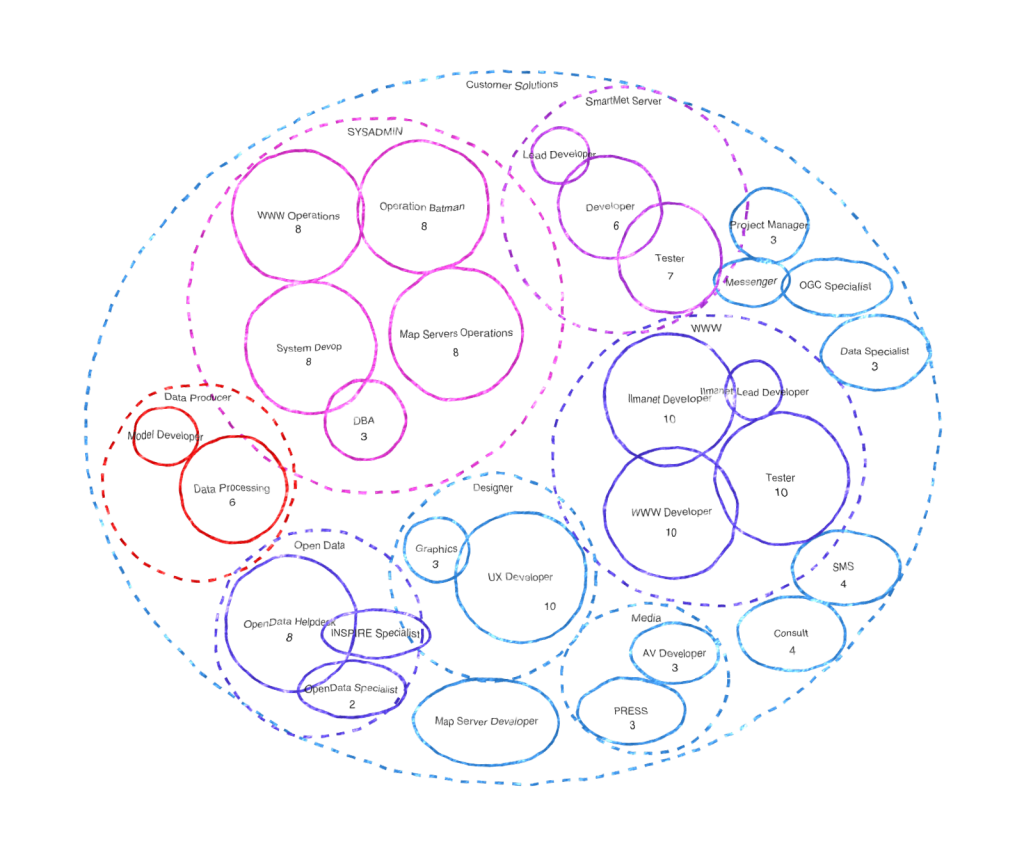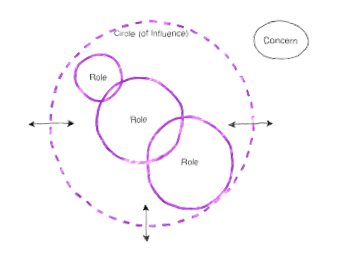Circles of Influence
In the last post I picked up three points to be learned from holacracy1, new way to be organised at companies. Let’s recall them again:
- Meeting habits, specially one tension at the time2 is a very useful principle to keep meetings concise.
- ”What do you need?” is a great question to emphasises responsibility of individuals.
- Drawing circles as they exist at the moment and as they should exist is a great exercise. The diagram can be used in many ways.
Now it’s time to dig into the circles and see how they can be used.
First some background information about our group. We are responsible for FMI B2B solutions. We are a DevOps3 team, we install and operate our servers from OS level upon. Basicly, our group has two major parts: SmartMet Server providing data interfaces and (mainly) web based UI development. SmartMet Server4 is a very high performign C++ server environment. At the moment it holds about 2 TB often updating data and response to over 30 million requests/day. Our web solutions are mainly concentrated on ’Ilmanet’ product delivery network where account managers can manage clients and their orders.
We are 15 people in total at the moment. Most of the people in our team are able to do most of its tasks. All core members of our group have to be able to operate the whole system and fix problems if necessary. I believe in generalisation against specialisation5. Although there may be some efficiency hit6, generalisation provides agility, adaptivity7 and keeps everyone’s skills up to date8.
Our circles looks like following. Dashed lines stand for the circles and solid lines represent roles. The outermost circle is our team in the organisation. Numbers under role names tell amount of people having that particular role. There of course are more overlaps between the circles than illustrated in the image. It would be useful to visualise these overlaps, but I did not manage to keep the diagram readable while doing so. Sizes of the circles in the image roughly illustrates an importance of the circle, not size of it.
So, what’s the point of drawing circles like this? The diagram can be used in several ways:
1) It’s a great tool for conversations. Who are in the circles? Should I be in that circle? What skills would I like to or I need to learn in the future? Should I get off from some circle? Should I join in some circle? In my internal version I of course have people’s names in the circles instead of people count.
2) Above image describes the current situations but of course it’s useful to think what circles should we have? Especially, should we get rid of some? For example we should consider to establish a circle of consultants gaining and providing other circles and our clients special knowledge about standards and other technologies needed in our domain. Members of circle could map together what kind of knowledge should be acquired in the future, organise some workshops to other circles and so on… OGC9 Specialist, INSPIRE10 Specialist, Data Specialist and Consultant would at least be in the group.
3) Should we merge or split some activities? It’s notable that merging and splitting activities has direct implications to what skills people will have. In this case Sysadmin circle could and maybe should be exploded into other circles. Although this way developing production environment is easier to separate to its own role.
4) This kind of illustration is a great tool to structure group’s work. Having a clear idea what is needed and how one’s work supports others helps everyone to see what’s important and what’s not. It also motivates people: why is my work important? What’s my ten cents to this community? Holacracy indeed is a very purpose driven way to organise. This kind of exercise encourages to define clear purposes for all circles. Here are some examples from above image:
- Customer Solutions: Customer Solutions makes the best weather services in the World. We are fast and agile group with a state of the art knowledge of the newest technology and special skills to handle large data volumes.
- Sysadmin: Sysadmins provides an easy-to-use high-performance infrastructure for other circles to build services on. They keep the system and the services up and running ensuring high availability percents.
- SmartMet Server: SmartMet Server circle develops a high-performance and high-availability data server for internal and external systems and user interfaces. Thanks to them, other circles, FMI OpenData users and FMI customers can easily fetch data of their need.
- […]
Holacracy’s circles also reminds me about Stephen R Covey’s Circle of Concern and Circle of Influence11 introduced in his famous book The 7 Habits of Highly Effective People12. Covey noted that people have a circle of concerns encompassing a range of concerns we have in our life. People have also a circle of influence — their personal range to be able to affect things. Proactive people act with concerns they can affect and enlarge their circle of influence by numerous technics. Reactive people tend to focus their power out of range and their circle of influence shrinks. When having concerns at work, it may be beneficial to map the concerns and circles to the same map and see whether there is a circle and role to handle the problem.
I encourage every leader or anyone interested in to do the same exercise and discuss about that with others. It may not always be so clear how things are and how they should be. This work could of course be continued. To name one thing, it would be nice to visualise dependencies between the circles and the most important stakeholders.
1 https://en.wikipedia.org/wiki/Holacracy
2 https://blog.holacracy.org/one-thread-at-a-time-7b297718bc59
3 https://en.wikipedia.org/wiki/DevOps
4 http://www.slideshare.net/tervo/foss4g-fmi-opendataroopetervo
5 http://noop.nl/2008/04/specialization.html
6 http://www.bryanbraun.com/2012/01/22/generalizing-vs-specializing
7 http://tech.co/specialization-vs-generalization-business-strategy-2015-08
8 http://www.wisebread.com/is-it-better-to-specialize-or-generalize
9 http://www.opengeospatial.org
10 http://inspire.ec.europa.eu



